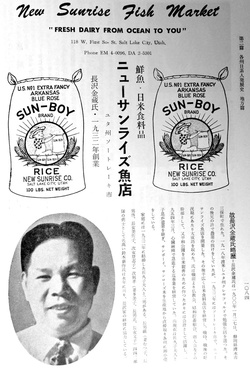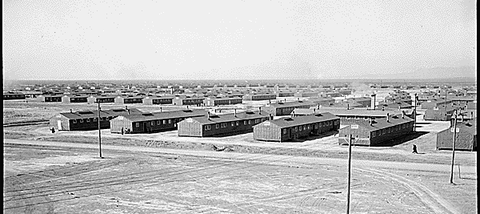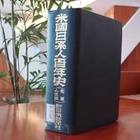Starting with railroads, mines, and agriculture
The state of Utah is located to the east of California, and Nevada to the east of Nevada. It borders Idaho and Wyoming to the north, Colorado to the east, and Arizona to the south. The climate is relatively dry, with four distinct seasons.
Utah, whose capital is Salt Lake City, famous for being a land developed by the Mormons, developed in the second half of the 19th century with the construction of railroads and the development of mines, among which were traces of Japanese presence. The "Centennial History" describes the early period as follows:
"Japanese people first came to the state in the early 1900s, sent by various contractors as railroad workers, farm laborers, or mine laborers. Prior to that, around 1890, Japanese prostitutes came to Ogden, Utah, and then similar Japanese women who had flocked in from the Biyute area of Montana also appeared in Sault Lake. At that time, there were already a number of Japanese living in these areas, and it is said that honest people there did everything they could to oppose the Japanese engaging in prostitution, eventually driving them out."
Japanese language schools also spread
Like Montana, which I introduced in my previous article , and other areas that developed through railroads and coal mining, Utah also saw a large number of contract laborers sent by Japanese labor placement companies to work on railroad construction, coal mines, and sugar beet farms. This began in 1903-1904.
The origin of agriculture was a year earlier, when Ijuin Kaneo, a native of Kagoshima Prefecture, established a farm on the outskirts of Ogden in 1902. As for Japanese commerce, a Japanese association was formed around 1910, and various stores such as soba restaurants and barber shops were opened and businesses were conducted.
Looking at the Japanese in Utah by occupation in 1930, there were 840 mining and metallurgical workers, 428 farming, horticulture, and livestock, and 285 railroad workers.
Agricultural associations were also formed in various places. As for religious organizations, the Ogden Japanese Christian Church held meetings in 1905. A Buddhist church was also founded later. As the second generation grew, a Japanese language school (gakuen) was also established in 1924. As of 1940, there were a total of 11 schools with a total of 521 students.
Newspapers such as the Utah Daily News are published.
Newspaper publishing began soon after Japanese people arrived in the area. First, in 1907, Saburo Iida (head of the Ogden branch of the Japan-America Bank of San Francisco) who lived in Ogden published the mimeographed newspaper "Roki Jiho," but it ceased publication after the third issue. It was later replaced by movable type printing.
On November 3, 1914, Terazawa Kazuo founded the Utah Nippo in Salt Lake City. It was read by Japanese people living in Utah, Idaho, Wyoming, and Nevada. The Utah Nippo later acquired the Rokuki Jiho and, after becoming a joint-stock company, also established an English column.
When war broke out between Japan and the United States, Japanese-language newspapers along the Pacific coast ceased publication. Also, as Japanese people on the Pacific coast migrated to Utah, the Utah Nippo gained more readers, with circulation at one point approaching 10,000, and it became a source of information for Japanese Americans during the war.
At the heart of the Japanese community during the war
As the Utah Nippo newspaper example shows, the outbreak of the war between Japan and the United States had a different impact on the Japanese community in Utah than it did on the Pacific coast. To borrow a phrase from the Centennial History:
"In the spring of 1942, a forced evacuation order was issued for 110,000 Japanese people from the three western coastal states, and many of them tried to evacuate to the interior states. Most states, with a few exceptions, refused to allow them to enter, but Utah, which had originally been developed by the Mormons and had been pro-Japanese from early on, welcomed the Japanese people, and immigrants flooded in one after another from all over the three coastal states, especially California. At one time, many Japanese people numbered several thousand in the centers of Salt Lake and Ogden, and they worked in commerce, agriculture, canneries, and as domestic laborers. As a result, the Japanese neighborhoods in these two cities, which had been in decline before the war, suddenly became very prosperous."
"After that, many people from the Topaz relocation address in the state and the Minnedoka relocation address in Idaho relocated to the state, and the Japanese population in Utah increased rapidly. At the same time, due to the fact that the wartime Western Army Defense Command was established in Salt Lake, the headquarters of the National Japanese Citizens Association was also moved to Salt Lake, and Chairman Saburo Kido and others set up offices in the city. Conferences of representatives from the various relocation addresses were also frequently held in the city, making it the center of the Japanese community in America during the war."
Japanese Americans remain after the war
The Topaz Relocation Center (camp) was located in southwestern Utah, and at its peak, nearly 8,000 people were incarcerated there. After the removal order was lifted, some people tried farming in the state. However, the inmates later returned to California, and the Japanese population in Salt Lake and Ogden dropped sharply.
That being said, the Japanese population in Utah, which was 2,210 before the war, roughly doubled after the war, and in the 1960 census, the population was 4,371, not much different from 1950. The Centennial History gives the reasons for this trend as "the religious atmosphere makes it a comfortable place to live, and some families remain because their children have married off."
He concludes, "This shows that Japanese people in Utah have already established themselves here, having survived the tense times of wartime."
(Note: I have used the original quotes as much as possible, but have made some edits.)
* Next time, we will cover "Japanese Americans in Nevada."
© 2015 Ryusuke Kawai








